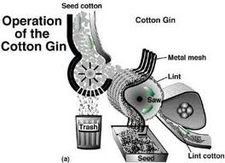Cotton Fiber Ginning
The process of separating the seeds from the cotton fibers. Types of processes, Points to be considered for fibre during processing. It also mentions various other properties.
Cotton gins are factories that complete the first stage of processing cotton – separating the lint from the seed. Gin is short for en-“gin”. Generally, gins are located in cotton areas to avoid costly transport. Before the gin was invented, the lint and seed were separated by hand. It took one person a whole day to separate only half a kilo of the lint from the cottonseed. Modern gins can separate and bale about 230,000 kilograms of cotton in one day.
Ginning is the first mechanical process involved in processing cotton. Ginning machine separates cotton fibers from the seed bolls and dust particles. Cotton fibers pressed to Bales by using the Hydraulic pressing machine. The development of different varieties, Fiber growth, Grading, and Marketing.
THE GINNING PROCESS
The seed cotton arrives at the gin in round bales or modules.
- The first step in the ginning process is where the cotton is vacuumed into tubes that carry it to a dryer. Cotton must be ginned with a moisture level of 5%. The cotton is dried out if it is too wet or water is added if it is too dry to ensure the correct moisture level.
- Next, the cotton goes through several stages of cleaning equipment to remove leaf trash, sticks, dirt and other foreign matter.
- After cleaning, the cotton is then ready for separation in the gin stand. The gin stand removes the seed from the lint. Most cotton is ginned with saw gins where fast moving circular saws grip the fibers and pull them through narrow slots.
- The raw fiber, now called lint, has any remaining trash removed and makes its way through another series of pipes to a press where it is squashed into bales under very high pressure. Each bale weighs 227kg.
- Samples are taken from each bale for classing and the bales are wrapped in stretchy white cotton fabric to protect the lint.
- They are now ready for transport to one of the ports for shipping into overseas markets.
Textile Yarns processing technology
Ginning: The process of separating the seeds from the cotton fibers is known as ginning.
There are 3 types of ginning processes. They are:

- Knife roller gin for Indian and Pakistani cotton
- McCarthy roller gin for Long staple cotton
- Saw gin used for American, West African, Pakistani cotton
Types of textile fibers – list of textile fibers by its sources
A comprehensive textile fabric names by fiber sources
Points to be considered for fiber during processing:
Main Factors
- Length
- Fineness
- Maturity
- Uniformity
- Trash Content
Other Properties
- Pliability
- Cohesiveness
- Tensile Strength
The selection criteria of seed cotton
In cases where the seed cotton is brought in modules and the farmer himself owns the cotton
no grading used to take place at the ginning factory premises but in view of increased
electrical power costs the ginning factories have started grading the same for moisture and
trash contents to decide the level of drying and cleaning required and the job work charges are
varied depending on moisture and trash contents as the cost of single or double stage drying
and cleaning varies.
- Leaf grade: Leaf grade refers to the leaf or trash content in the cotton. Graded on a scale of 1 to 8, leaf grade is determined by human classers who compare a lint sample to Universal standards for the grades. A leaf grade of 8 is referred to as “below grade”, and can result in large price discounts.
- Fiber length: Fibre length is primarily determined by cotton variety, but growing conditions and fertility can affect length as well. Night time temperatures of 60-70ºF are optimum for fiber length development. Temperatures above or below this range result in shorter fibers. Reduced length can also result from a deficit or excess soil moisture levels.
- Length uniformity: Length uniformity is the ratio between the mean length of the fiber and the upper half mean length expressed as a percentage. Low uniformity values are a function of fibers that are more easily broken.
- Strength: Strength is measured by clamping and breaking the beard of fibers with a 1/8-inch gage spacing between the clamp jaws. The strength reported is the force in grams required to break a bundle of fibers one tex unit in size.
Micronaire: Micronaire (mike) is a measure of the fineness of the cotton fiber. Unlike fiber length, mike is determined more by environmental conditions than variety. Mike is developed after the full fiber length is obtained.
Trash: Trash is a measurement of trash present in the lint. The measurement is made by the HVI video trash meter which measures the percentage area and particle count of trash on the sample surface. This measurement provides an estimate of the total amount of trash in the bale. - Color: Colour is the measure of greyness and yellowness of the lint. Reported as a two-digit code as measured by the HVI, color usually is not affected by variety.
- Moisture: The Roller Gins can take up to 10-11%moisture but above that, the drying process should be adopted before feeding the seed cotton to the ginning machines
and the moisture contents should be brought down to below 10% before ginning.
Technologies used for Ginning Seed Cotton
- Saw Ginning
- Roller Ginning
- Double Roller Ginning
- Single Roller Ginning
- Rotobar Rotary Knife Roller Ginning



Lab Saw Ginning Machine is used for separating seed cotton. After ginning, cotton fiber with trash, leaf, dust… is collected, and cottonseed with a little clean lint is collected in another container. Please contact us for cotton ginning machine by
www.testextextile.com/product/lab-saw-cotton-gin-tb510b